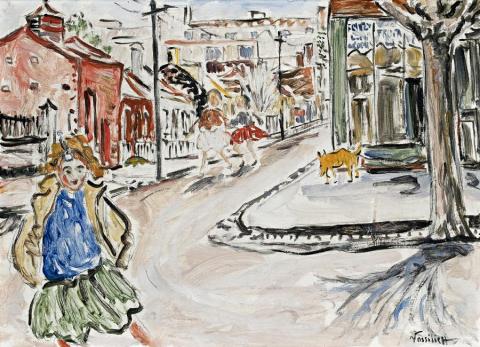FITZROY STREET SCENE, 1938
Danila Vassilieff
oil on plywood
39.0 x 54.5 cm
signed lower right: Vassilieff
Mr and Mrs David Aron, Melbourne
Niagara Galleries, Melbourne
The Hicks Family Collection, Melbourne
Moore, F. St. J., Vassilieff and His Art, Oxford University Press, Melbourne, 1982, p. 147, cat. P103
Reviewing Danila Vassilieff's Melbourne exhibition in October 1938, Vance Palmer wrote: ‘His is easily one of the most brilliant new talents we have seen here in recent years. As a naturalized Australian he is one of the few who is giving expression to an aspect of Australian life rather than imitating a physical aspect of the country itself. I suggest that Melbourne may have some cause to be ashamed of its neglect of Vassilieff in the fullness of time as Paris for its former scorn of Gauguin and Van Gogh.’1 One of the most colourful figures of his time, Vassilieff was born at Kagalnickaya, southern Russia, the son of a Cossack father and a mother from a family of icon painters. Danila served on the Western Front in the Cossack cavalry, then as a Lieutenant-Colonel in the Counter Revolution. Imprisoned, he escaped, living in Azerbaijan and Persia, making his way to China and marriage to another refugee, before arriving in Australia in 1923. Sugar cane farming in Queensland, studying art in Paris then Rio de Janeiro, living and exhibiting in the West Indies, England, Spain, he eventually returned to Australia in 1935. In 1937 he moved to Melbourne, settling first in Fitzroy, painting the neighbourhood and its people.
Fitzroy Street Scene 1938 is a classic example of the time both in subject and execution. The close-up figure of the girl to the left and the colourful accent of the yellow dog provide that characteristic emphasis on the picture plane, which distinguishes his finest paintings. The eye led into the picture by the long, narrow street, returns to the plane through the pair of young girls walking towards the viewer - and then into the viewer's space itself by the figure balancing on the picture's very edge. The mood and technique are full of vivacity and spontaneity, sketched across a white ground, the directness of notation - the brief, drawn strokes of colour - so suggestive of movement. While it has been said that the limited use of paint and restricted palette act as metaphors of the poverty surrounding him, Fitzroy Street Scene shows that the artist and his subjects share an engaging, quizzical interest in life. ‘He does not need to go searching for subjects,’ his wife Helen told a reporter from the Herald newspaper. ‘…he often has a chat with the children of the neighbourhood and paints them too… the children flock around her husband, he has many friends too with the dogs of the neighbourhood who are always apt to be painted into the street scene.’2
1. Palmer, V., Catalogue introduction, Riddell Galleries, Melbourne, October 1938, quoted in Moore, op. cit., p. 47
2. Herald, Melbourne, 23 February 1938, quoted in Moore, op. cit., p. 43
DAVID THOMAS
